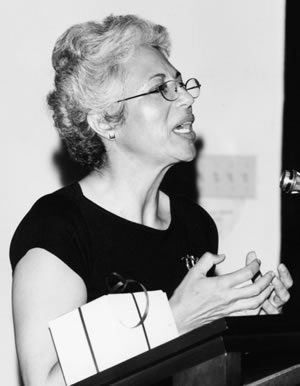Claudia Smith
Claudia Smith was born and raised in Guatemala but attended college in the United States. As she was about to graduate from George Washington University and go on to graduate school in Latin American studies, Claudia attended a speech given by Cesar Chavez. Soon she was on her way to California. Since then, with both determination and imagination, she has dedicated her life to serving migrants from Mexico, Guatemala, and elsewhere in Central America. In pursuit of her path, Claudia entered a Dominican convent, went to work in 1973 for the California Rural Legal Assistance program, and became a lawyer so that she would have more tools to help her clients. Reluctantly, she chose to leave the convent so that she could pursue her cause without interruption.
Over the years, Claudia focused more and more on issues concerning the United States’ enforcement of its border with Mexico. In 1987, she opened and ran a new CRLA office at the Mexican-American border and when the rules governing CRLA became more restrictive, she helped to establish the California Rural Legal Assistance Foundation to carry out activities forbidden to CRLA. She filed a Freedom of Information Act request concerning the Immigration and Naturalization Service’s standards for treatment of detainees, discovered that there were none, forced the establishment of standards and set about monitoring whether they were being followed by interviewing detained immigrants. When she saw that often almost twice as many people were packed into vehicles containing detained immigrants as they were supposed to hold, she began asking about the legal limitations on numbers of people in vehicles and pressuring the government to reduce the serious overcrowding. Claudia constantly struggles to make sure that water is provided to detainees who are captured in the desert, bused over long distances, or held in a hot car or bus for hours near the border.
With the advent of Operation Gatekeeper in 1994, both the threat to migrants and the resulting range of activities pursued by Claudia increased dramatically. The strategy of Operation Gatekeeper is to funnel people attempting to cross the border into inhospitable places and conditions—the desert, dangerous mountains, bombing ranges, and some of the most polluted waterways in the Western Hemisphere. Predictably, this has not so much discouraged emigration as put the migrants in great danger. As a result, more than 500 people have died along the border between the United States and Mexico over the last two years. For each one, Claudia has made and installed a wooden cross on the Mexican side of the border. She has created a web site with data and articles on conditions at the border. She has established liaisons with faith-based and other organizations in the United States and Mexico to work together on these problems. They have filed a petition with the Organization of American States charging that aspect of Operation Gatekeeper are in violation of inter-American agreements. Finally, through persistent, bold, and politically sophisticated efforts, she and her allies have attracted the attention of the head of the UN Commission on Human Rights and of other human rights groups to the abuse of the right to border control.
Working with scant financial support and no model, Claudia Smith simply does whatever she can think of to help her chosen clients. She does it all, from making crosses and providing water to testifying before the UN Commission on Human Rights in Geneva. If it may help, it has to be done; and if no one else is doing it, she does it.
 Photo by Dorothea von Haeften
Photo by Dorothea von Haeften